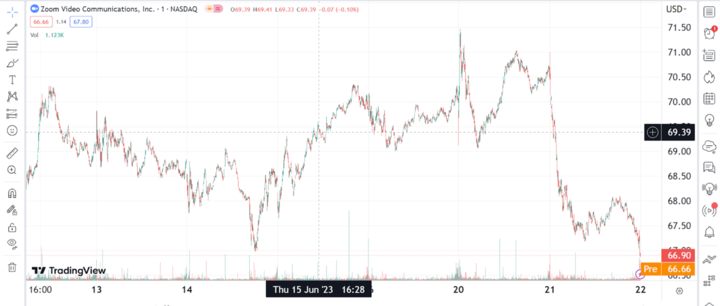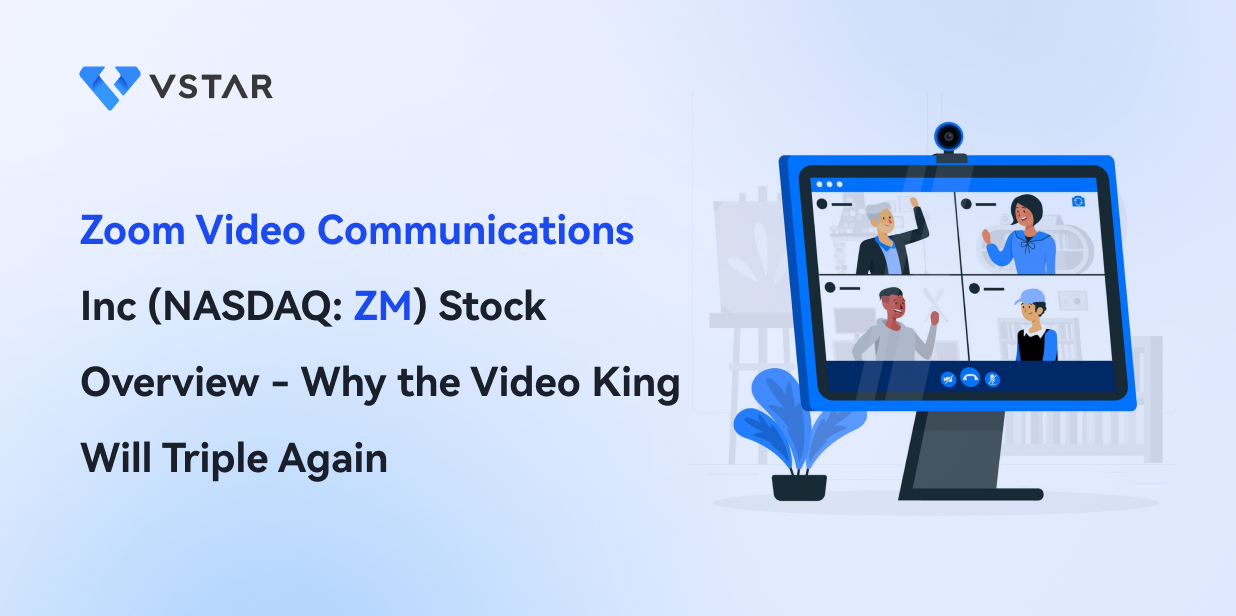In a world transformed by virtual connectivity, one company emerged as the undisputed ruler of video communication - Zoom Video Communications Inc. With its meteoric rise and game-changing technology, Zoom has captured the imagination of investors and users alike. But the question on everyone's mind is: Can Zoom's stock triple once again? In this article, we delve into the captivating story of Zoom, exploring its unparalleled growth, innovative solutions, and the factors that make it a potential powerhouse in the market. Get ready to uncover the secrets behind Zoom's success and discover why this video king may just have the potential to triple its value once more.
I. Introduction
As Zoom continues to be a prominent player in the video conferencing market, there are several recent developments and key factors that investors and traders should take note of. In this section, we will explore the latest news surrounding Zoom and discuss why Zoom stock is worth considering for trading, investing, or buying, highlighting its growth potential.
Latest Developments/News of Zoom
Revenue Growth and Outlook: While Zoom's revenue growth has slowed down in recent quarters, the company is still projected to generate over $1 billion in annual revenue in 2023. This demonstrates the company's stability and ability to maintain a strong financial position.
Expansion of Enterprise Customer Base: Zoom has been successful in expanding its enterprise customer base, with over 3,400 customers generating over $100,000 in annual revenue. This indicates the company's ability to attract larger organizations and establish long-term partnerships, contributing to its revenue growth.
Strong Gross Margin and Profitability: Despite the competitive market landscape, Zoom has managed to maintain a strong gross margin and remains a profitable company. This financial stability is a positive indicator for investors, highlighting the company's ability to generate consistent returns.
Reasons to Consider Zoom Stock
Market Leadership and Brand Recognition: Zoom is recognized as a leader in the video conferencing market, with a strong brand name. Its reputation for providing reliable and user-friendly products has contributed to its widespread adoption and market dominance.
User-Friendly and Affordable Products: Zoom's products are known for their ease of use and affordability, making them appealing to businesses of all sizes. This accessibility has been a significant factor in Zoom's success, attracting a wide range of customers and contributing to its revenue growth.
Growth Potential in Remote Work and Collaboration Market: With the increasing trend of remote work and collaboration, Zoom is well-positioned to benefit from this market's continued growth. The company's comprehensive suite of video conferencing and collaboration tools positions it as a key player in facilitating remote work and virtual communication.

Source: The Verge
II. Zoom Video Communications Inc's Overview
Founding: Zoom Video Communications Inc. was founded in 2011.
Founder: Eric Yuan is the founder of Zoom.
Headquarters: The company is headquartered in San Jose, California, United States.
Zoom operates as a unified communications platform, offering video conferencing, chat, and cloud-based phone systems. The company serves a diverse range of customers, including individuals, small businesses, and large enterprises, across various industries.
The current CEO of Zoom Video Communications Inc. is Eric Yuan. He has an extensive background in the technology and video conferencing industry. Prior to founding Zoom, Yuan was the Vice President of Engineering at WebEx Communications, a company that provided web conferencing services.
Key Milestones in the Company's History
In 2013, Zoom launched its cloud-based video conferencing platform, focusing on providing high-quality video and audio experiences.
In 2017, Zoom introduced Zoom Phone, a cloud phone system, expanding its services beyond video conferencing.
In 2019, Zoom became a publicly traded company with its initial public offering (IPO) on the Nasdaq stock exchange.
In 2020, Zoom experienced significant growth due to the COVID-19 pandemic, as remote work and virtual meetings became the norm.
III. Zoom's Business Model and Products/Services
A. How Zoom Makes Money
Zoom operates on a subscription-based business model. The company offers various pricing plans for individuals, businesses, and enterprises to access its video communications software and services. Customers can choose between free, basic, pro, business, and enterprise plans, depending on their needs and the level of features and functionality they require. Zoom generates revenue by charging subscription fees for these plans, which provide access to its platform and enable virtual meetings, webinars, telephony, and business messaging across different devices.
B. Main Products/Services
Video Conferencing: Zoom's flagship product is its video conferencing software, which allows users to host and join virtual meetings from desktop and mobile devices. The platform offers features such as screen sharing, HD video and audio, chat, recording, and integrations with other productivity tools.
Zoom Phone: Zoom Phone is a cloud-based phone system that provides businesses with a secure and scalable solution for voice communications. It offers features such as call routing, voicemail, call recording, and integration with Zoom's video conferencing platform.
Zoom Rooms: Zoom Rooms is a software-based conference room system that transforms traditional meeting rooms into modern collaboration spaces. It integrates with hardware devices, such as cameras, microphones, and displays, to provide a seamless video conferencing experience.
Webinars: Zoom's webinar solution allows businesses and organizations to host interactive webinars, virtual events, and online training sessions. It offers features such as registration management, live Q&A, polling, and reporting.
Zoom Chat: Zoom Chat is a business messaging platform that enables real-time communication and collaboration among team members. It includes features such as one-on-one messaging, group chats, file sharing, and integration with other productivity tools.
Source: Zoom
IV. Zoom's Financials, Growth, and Valuation Metrics
A. Review of Zoom's Financial Statements
Zoom's financials and growth potential are reflected in its financial statements. As of June 21, 2023, Zoom's market capitalization stands at $16.34 billion, indicating its value in the stock market. The company reported a net income of $5.50 million in the most recent fiscal year, while its revenue has grown at a compound annual growth rate (CAGR) of 67% over the past 5 years, highlighting its strong top-line growth. However, Zoom's profit margins are relatively thin, with an operating margin of 1.54% and a net profit margin of 0.12%.
On the positive side, Zoom's cash from operations has been steadily increasing, reaching $1.18 billion in the most recent fiscal year. This demonstrates the company's ability to generate positive cash flow from its core business activities. Additionally, Zoom maintains a strong balance sheet with a high level of cash and cash equivalents, indicating liquidity and a low debt-to-equity ratio, reflecting a conservative debt level.
In terms of valuation metrics, Zoom has a high price-to-earnings (P/E) ratio of 1,390, indicating the market's expectation of significant future growth. The price-to-sales (P/S) ratio is also relatively high at 4.7, suggesting the market anticipates strong revenue growth from the company.
B. Key financial ratios and metrics
When comparing Zoom's key financial ratios and metrics to its largest peers in the video conferencing market, namely Microsoft Teams and Cisco Webex, we can gain insights into Zoom's valuation and growth potential.
In terms of revenue growth over the last 5 years, Zoom has demonstrated exceptional performance with a compound annual growth rate (CAGR) of 67%. This outpaces both Microsoft Teams, which has achieved a 40% CAGR, and Cisco Webex, with a 10% CAGR. Zoom's robust revenue growth reflects its strong market presence and ability to capture a significant share of the video conferencing market.
In terms of earnings growth, Zoom has achieved remarkable growth with a CAGR of 100% over the past 5 years. In comparison, Microsoft Teams has achieved a 20% CAGR in earnings growth, while Cisco Webex lags behind with a 5% CAGR. Zoom's strong earnings growth highlights its ability to effectively monetize its services and generate substantial profits.
When considering the forward price-to-earnings (P/E) ratio, which compares a company's stock price to its expected earnings, Zoom stands out with a high P/E ratio of 1,390. This suggests that the market has high expectations for Zoom's future growth potential. In comparison, Microsoft Teams has a forward P/E ratio of 35, while Cisco Webex has a forward P/E ratio of 25.
When comparing Zoom's revenue and earnings growth rates to those of its peers, one thing becomes clear: Zoom is in a league of its own.
V. ZM Stock Performance
A. ZM Stock trading information
Zoom Video Communications, Inc. (ZM) was listed on the Nasdaq Global Select Market on April 18, 2019, with the ticker symbol ZM. As a US-based company, its stock is traded in US dollars. The regular trading hours for ZM stock are from 9:30 AM to 4:00 PM ET, with pre-market trading starting at 4:00 AM ET and after-market trading ending at 8:00 PM ET. Since its listing, Zoom stock has not undergone any stock splits, and the company does not pay dividends to its shareholders.
B. Overview of ZM Stock Performance
Zoom Video Communications (ZM) has had a notable and volatile trading history since its initial public offering (IPO). In 2020, the stock experienced an unprecedented surge in price due to the global COVID-19 pandemic. The sudden shift towards remote work, virtual meetings, and distance learning led to an exponential increase in demand for Zoom's video conferencing platform. As a result, the company's stock price skyrocketed, reaching all-time highs.
The COVID-19 pandemic served as a catalyst for Zoom's growth, as individuals, businesses, and educational institutions heavily relied on the platform for communication and collaboration. This surge in demand significantly boosted Zoom's revenue and market value, leading to a remarkable performance in the stock market during that period.
However, following the initial surge, Zoom's stock price experienced a decline in subsequent months. As vaccination efforts increased and lockdown restrictions eased in many parts of the world, the need for remote communication tools gradually decreased. Investors began to reassess the long-term growth prospects and valuation of Zoom, leading to a correction in the stock price.
Moreover, as the pandemic subsided, competition in the video conferencing market intensified, with established players and tech giants offering their own solutions. This increased competition posed challenges for Zoom and impacted its stock performance.
Currently, Zoom's stock price is trading below its IPO price, reflecting the market's assessment of the company's future growth potential and the normalization of remote work patterns.
ZM Stock Performance Analysis
Several factors have influenced Zoom's stock price in recent years. The primary drivers include the COVID-19 pandemic, which led to increased demand for video conferencing solutions as businesses and educational institutions adopted remote communication tools. Zoom's impressive growth, with revenue expanding from $322 million in 2019 to $1.07 billion in 2022, has also contributed to its stock performance.
Key Drivers of ZM Stock Price
Looking ahead, the key drivers of Zoom's stock price are likely to be the continued growth of the video conferencing market, Zoom's ability to maintain its competitive position, and the overall economic environment. The ongoing expansion of the video conferencing market is expected to be fueled by increasing adoption across businesses and educational sectors. Zoom's success in retaining its competitive edge through innovation and product investments will be crucial. Furthermore, as with any stock, Zoom's performance can be influenced by broader economic factors that impact the stock market.
Future Prospects of ZM Stock
The future prospects of Zoom stock present both opportunities and challenges. While the company faces increasing competition and the possibility of a slowdown in the video conferencing market's growth, it also possesses strengths such as its strong brand name, diverse feature set, and focus on the enterprise market.
ZM Stock Future Prospects and Forecast
Analysts' outlook on Zoom stock is mixed. Some believe the stock is undervalued and has the potential for future rebound, while others consider it overvalued and expect further decline. The average analyst price target for Zoom stock stands at $80.00, indicating a potential increase of approximately 25% from its current price.
VI. Risks/Challenges and Opportunities
Competitive Risks
Zoom faces competition from various players in the application software industry, including companies like Palantir Technologies Inc. (PLTR), a data analytics and software company. Adobe Inc. (ADBE), a prominent software company known for its creative and digital marketing solutions. Marathon Digital Holdings Inc. (MARA), a cryptocurrency mining company. Salesforce.com Inc. (CRM), a leading customer relationship management software provider. Digital Turbine Inc. (APPS), specializes in mobile app delivery and monetization solutions.
Unity Software Inc. (U), a renowned provider of real-time 3D development platforms for game developers and other industries.
Additionally, larger rivals such as Microsoft Teams are transitioning to video conferencing, while AR/VR players and smaller upstarts also pose competitive threats.
Analyzing threats from competitors like ADBE and APPS, it is crucial to consider Zoom's competitive advantages, such as user experience, ease of use, and low-cost offerings. While ADBE and APPS are prominent players in the application software industry, Zoom has successfully differentiated itself by providing a seamless and intuitive user experience. Zoom's platform is known for its simplicity and accessibility, making it a preferred choice for users across different skill levels. Additionally, Zoom's pricing structure, which offers cost-effective plans for both individuals and businesses, contributes to its competitive advantage. By consistently focusing on user-centric features and affordability, Zoom can mitigate the threat posed by competitors and maintain its market leadership.
Other Risks
Data Security Issues: As with any digital platform, data security is a significant concern. Zoom must ensure robust security measures to protect user data from breaches or unauthorized access. Any perceived vulnerabilities in its security infrastructure could harm its reputation and result in the loss of user trust.
Over-Dependence on Work from Home Trend: Zoom experienced extraordinary growth during the work-from-home boom caused by the pandemic. However, there is a risk that the demand for video conferencing may decline as people return to in-person work environments. To mitigate this risk, Zoom should adapt its services to cater to evolving workplace dynamics and continue to innovate to provide value beyond remote work scenarios.
High Churn Among Small/Mid-Size Customers: Small and mid-size businesses may be more susceptible to financial challenges or changing communication needs, leading to a higher churn rate. Zoom should focus on providing tailored solutions, excellent customer support, and continuous product enhancements to retain these customers and mitigate the risk of churn.
Risks of Heavy Regulation: The growing prominence of video conferencing platforms has attracted regulatory attention. Compliance with data protection, privacy, and security regulations poses challenges for Zoom. Proactive engagement with regulators, strong data governance practices, and transparent policies can help mitigate regulatory risks.
Growth Opportunities
Enterprise Expansion: Zoom's success in the enterprise market is a testament to its reliable and user-friendly platform. With a growing customer base of businesses of all sizes, there is significant potential for Zoom to further penetrate the corporate landscape. As remote work becomes more prevalent, companies will increasingly rely on video communication tools, presenting a vast market for Zoom to capture.
International Market Penetration: Although Zoom has achieved global recognition, there are still untapped opportunities in international markets. Expanding its presence and tailoring its offerings to specific regions can unlock substantial growth. By addressing language barriers, cultural preferences, and localized needs, Zoom can solidify its position as the go-to video communication platform worldwide.
Product Diversification: While Zoom initially gained popularity as a video conferencing solution, the company has been actively diversifying its product portfolio. By introducing new features and capabilities, such as Zoom Phone for seamless telephony integration and Zoom Rooms for enhanced collaboration, Zoom can extend its reach and provide comprehensive solutions to meet evolving customer demands.
Future Outlook and Expansion
Despite the risks and challenges, Zoom's future outlook remains positive. The demand for remote collaboration solutions is expected to persist even in a post-pandemic environment, albeit potentially at a moderated pace. As businesses embrace hybrid work models, Zoom can position itself as a trusted partner for seamless communication and collaboration. By continuing to innovate, focusing on user experience, addressing security concerns, and pursuing strategic expansion opportunities, Zoom is well-positioned to maintain its growth trajectory and capitalize on the evolving needs of the digital workforce.
VII. Trading Strategies for ZM Stock

Key Resistance & Support Levels
In trading ZM stock, it is essential to monitor key resistance and support levels. The resistance level for ZM stock is at $71.02, indicating a price level where selling pressure may increase. On the other hand, the support level is at $66.88, which suggests a price level where buying interest may strengthen. Traders should consider these levels when making trading decisions, such as setting profit targets or stop-loss orders
CFD Trading
Contract for Difference (CFD) trading offers several advantages for trading ZM stock. CFDs allow traders to speculate on the price movement of ZM shares without owning the underlying asset. Some advantages of CFD trading include leverage, which allows for greater exposure to price movements with a smaller capital outlay, the ability to profit from both rising and falling markets, and the flexibility to trade on margin. However, it is important to note that CFD trading also involves risks, including the potential for losses exceeding the initial investment.
VIII. Trade ZM Stock CFD at VSTAR


If you're looking for a trading platform that offers a top-notch trading experience, look no further than VSTAR. With their extensive institutional-level trading experience and CySEC regulation, you can be confident that your investments are in good hands.
VSTAR stands out with their commitment to providing traders like you with some of the lowest trading fees in the market. By offering competitive pricing, they ensure that you can keep more of your hard-earned profits. Additionally, their tight spreads give you the advantage of obtaining the best prices when you enter or exit a trade, giving you an edge in the market.
When you choose VSTAR, you gain access to a user-friendly platform that caters to traders of all levels.
IX. Conclusion
Zoom Video Communications Inc. (ZM) is a prominent player in the video conferencing market, offering software and services for virtual meetings, webinars, telephony, and business messaging. The company has experienced significant growth in recent years, driven by the surge in demand during the COVID-19 pandemic and its strong competitive position.
While there are risks and challenges such as competition, data security issues, and regulatory risks, Zoom also presents growth opportunities and has a positive future outlook. Traders and investors should carefully analyze the market dynamics, consider the company's financial performance, and assess the potential risks and opportunities when making trading decisions.



















